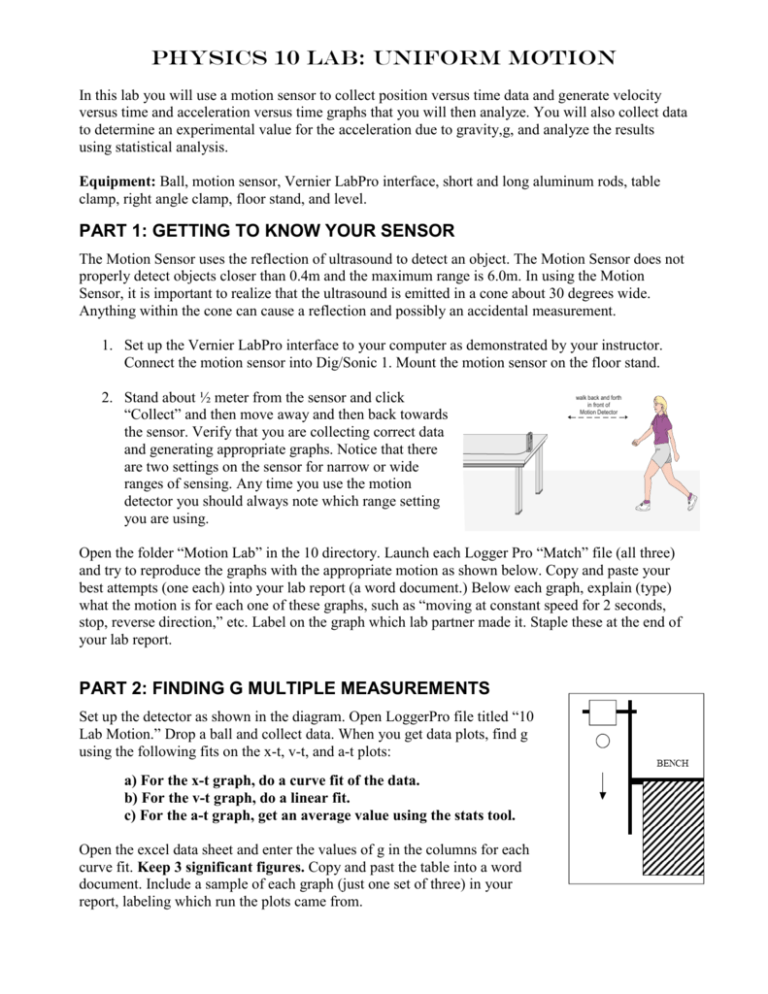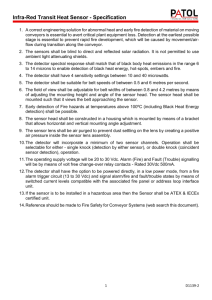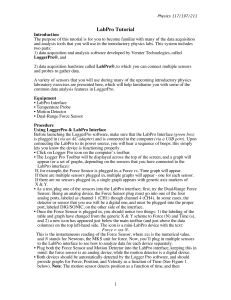Physics 40 Lab 2: Uniform Motion & Motion Detector
advertisement

Physics 10 Lab: Uniform Motion In this lab you will use a motion sensor to collect position versus time data and generate velocity versus time and acceleration versus time graphs that you will then analyze. You will also collect data to determine an experimental value for the acceleration due to gravity,g, and analyze the results using statistical analysis. Equipment: Ball, motion sensor, Vernier LabPro interface, short and long aluminum rods, table clamp, right angle clamp, floor stand, and level. PART 1: GETTING TO KNOW YOUR SENSOR The Motion Sensor uses the reflection of ultrasound to detect an object. The Motion Sensor does not properly detect objects closer than 0.4m and the maximum range is 6.0m. In using the Motion Sensor, it is important to realize that the ultrasound is emitted in a cone about 30 degrees wide. Anything within the cone can cause a reflection and possibly an accidental measurement. 1. Set up the Vernier LabPro interface to your computer as demonstrated by your instructor. Connect the motion sensor into Dig/Sonic 1. Mount the motion sensor on the floor stand. 2. Stand about ½ meter from the sensor and click “Collect” and then move away and then back towards the sensor. Verify that you are collecting correct data and generating appropriate graphs. Notice that there are two settings on the sensor for narrow or wide ranges of sensing. Any time you use the motion detector you should always note which range setting you are using. walk back and forth in front of Motion Detector Open the folder “Motion Lab” in the 10 directory. Launch each Logger Pro “Match” file (all three) and try to reproduce the graphs with the appropriate motion as shown below. Copy and paste your best attempts (one each) into your lab report (a word document.) Below each graph, explain (type) what the motion is for each one of these graphs, such as “moving at constant speed for 2 seconds, stop, reverse direction,” etc. Label on the graph which lab partner made it. Staple these at the end of your lab report. PART 2: FINDING G MULTIPLE MEASUREMENTS Set up the detector as shown in the diagram. Open LoggerPro file titled “10 Lab Motion.” Drop a ball and collect data. When you get data plots, find g using the following fits on the x-t, v-t, and a-t plots: a) For the x-t graph, do a curve fit of the data. b) For the v-t graph, do a linear fit. c) For the a-t graph, get an average value using the stats tool. Open the excel data sheet and enter the values of g in the columns for each curve fit. Keep 3 significant figures. Copy and past the table into a word document. Include a sample of each graph (just one set of three) in your report, labeling which run the plots came from. PART 2 CON’T: ANALYSIS OF THE DATA In Excel, find the average value and average deviation of each for each set of data for the x-t, v-t and a-t columns. Express your final values for g in ‘standard form’ using the average value as your final g and the standard deviation as your uncertainty. Box these. Label them. You should have three. Taking 9.80m/s^2 as the ‘true’ value of g, use Excel to find the discrepancy and % discrepancy for each set of data. Also, express your discrepancy as a multiple of your uncertainty and use the table below to determine the quality of the experimental agreement, that is, how well the results agree with the probability of a normal distribution. Then you can express your final results using all this information. Here is a sample: The experimental value of g (8.6+/-0.5)m/s^2 from the x-t data is off from the accepted value of 9.8 m/s^2 by 1.2 m/s^2, 12.2%, which is a discrepancy of 2.4 sigmas, which is fair agreement. Type a conclusion summarizing your results. Be sure to include the following, keeping it as concise and thorough as possible: 1. What was the goal of your experiment? What method did you use? 2. What assumptions did you make and how do you predict this will effect your results (make them higher, lower, etc.)? 3. What were your results (expressed with uncertainty) for each x-t, v-t and a-t plot? 4. What is the accepted value you are comparing it to? 5. Compare your results to the accepted value using discrepancy, percent discrepancy, discrepancy in terms of sigma and quality of agreement. 6. Which plot gave you the best agreement? For which plots did the true value fall within the range of experimental values.









